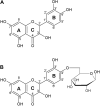Modulation of Chronic Inflammation by Quercetin: The Beneficial Effects on Obesity
- PMID: 32848440
- PMCID: PMC7425105
- DOI: 10.2147/JIR.S228361
Modulation of Chronic Inflammation by Quercetin: The Beneficial Effects on Obesity
Abstract
Obesity has become a major risk factor for the development of chronic diseases such as insulin resistance, type 2 diabetes mellitus, and cardiovascular disease. Moreover, obesity induces chronic inflammation in adipose tissue, liver, skeletal muscle, and the vascular system. Quercetin is the major representative of the flavonoid subclass of flavonols, which is ubiquitously contained within natural plants such as green tea, and vegetables, including onions and apples. Researchers have focused greater attention to the beneficial physiological roles of quercetin, which has anti-oxidative, anti-inflammatory, and anti-fibrotic effects on insulin resistance and atherosclerosis in obesity-related diseases. Also, the anti-inflammatory effects of quercetin on intestinal microbiota have been demonstrated in obesity. In addition, there is increasing evidence that quercetin is associated with epigenetic activities in cancer, and in maternal undernutrition during gestation and lactation. In this review, we focus on the chemical properties of quercetin, its dietary sources in obesity, and its anti-inflammatory effects on insulin resistance, atherosclerosis, intestinal microbiota, and maternal under-nutrition with epigenetic activity.
Keywords: atherosclerosis; inflammation; insulin resistance; obesity; quercetin.
© 2020 Sato and Mukai.
Conflict of interest statement
The authors declare no conflicts of interest.
Figures
Similar articles
-
Cardiovascular Disease: A Target for the Pharmacological Effects of Quercetin.Curr Top Med Chem. 2015;15(17):1735-42. doi: 10.2174/1568026615666150427124357. Curr Top Med Chem. 2015. PMID: 25915608 Review.
-
Protective effect of quercetin on high-fat diet-induced non-alcoholic fatty liver disease in mice is mediated by modulating intestinal microbiota imbalance and related gut-liver axis activation.Free Radic Biol Med. 2017 Jan;102:188-202. doi: 10.1016/j.freeradbiomed.2016.11.037. Epub 2016 Nov 25. Free Radic Biol Med. 2017. PMID: 27890642
-
A combination of quercetin and resveratrol reduces obesity in high-fat diet-fed rats by modulation of gut microbiota.Food Funct. 2017 Dec 13;8(12):4644-4656. doi: 10.1039/c7fo01383c. Food Funct. 2017. PMID: 29152632
-
The Pharmacological Activity, Biochemical Properties, and Pharmacokinetics of the Major Natural Polyphenolic Flavonoid: Quercetin.Foods. 2020 Mar 23;9(3):374. doi: 10.3390/foods9030374. Foods. 2020. PMID: 32210182 Free PMC article. Review.
-
Red wine is a poor source of bioavailable flavonols in men.J Nutr. 2001 Mar;131(3):745-8. doi: 10.1093/jn/131.3.745. J Nutr. 2001. PMID: 11238754 Clinical Trial.
Cited by
-
The Role of Quercetin as a Plant-Derived Bioactive Agent in Preventive Medicine and Treatment in Skin Disorders.Molecules. 2024 Jul 5;29(13):3206. doi: 10.3390/molecules29133206. Molecules. 2024. PMID: 38999158 Free PMC article. Review.
-
Antidepressant Potential of Quercetin and its Glycoside Derivatives: A Comprehensive Review and Update.Front Pharmacol. 2022 Apr 8;13:865376. doi: 10.3389/fphar.2022.865376. eCollection 2022. Front Pharmacol. 2022. PMID: 35462940 Free PMC article. Review.
-
Ameliorative properties of quercetin in the treatment of traumatic brain injury: a mechanistic review based on underlying mechanisms.Mol Biol Rep. 2024 May 25;51(1):695. doi: 10.1007/s11033-024-09641-z. Mol Biol Rep. 2024. PMID: 38796674 Review.
-
Targets and Effects of Common Biocompounds of Hibiscus sabdariffa (Delphinidin-3-Sambubiosid, Quercetin, and Hibiscus Acid) in Different Pathways of Human Cells According to a Bioinformatic Assay.Nutrients. 2024 Feb 19;16(4):566. doi: 10.3390/nu16040566. Nutrients. 2024. PMID: 38398890 Free PMC article.
-
Artemisia scoparia and Metabolic Health: Untapped Potential of an Ancient Remedy for Modern Use.Front Endocrinol (Lausanne). 2022 Feb 8;12:727061. doi: 10.3389/fendo.2021.727061. eCollection 2021. Front Endocrinol (Lausanne). 2022. PMID: 35211087 Free PMC article. Review.
References
Publication types
LinkOut - more resources
Full Text Sources


